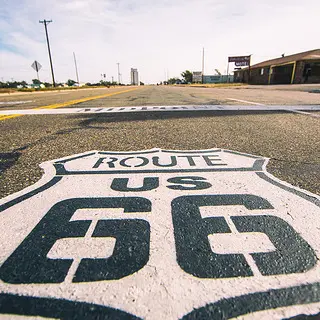
The Road of Flight: Three Authors Reflect on Their Route 66 Novels
“[Highway] 66 is the path of a people in flight, refugees from dust and shrinking land, from the thunder of tractors and shrinking ownership, from the desert's slow northward invasion, from the twisting winds that howl up out of Texas, from the floods that bring no richness to the land and steal what little richness is there […] 66 is the mother road, the road of flight.”
John Steinbeck’s portrayal of Route 66 in the classic 1939 novel The Grapes of Wrath not only gave the Mother Road its most famous nickname, but also helped preserve an essential part of its history. Before it came to be defined by its neon signage and quirky tourist attractions, the National Trust’s newest National Treasure represented a path that could lead to a better life, albeit fraught with peril and uncertainty.
This is the Route 66 that resonates most with author and historian Michael Wallis, one of its foremost experts. Wallis founded the nonprofit Route 66 Alliance, and his widely circulated 1990 book Route 66: The Mother Road helped reignite public interest in the route. It caught the eye of the animation studio Pixar, just as they were beginning work on a film set on the route featuring anthropomorphic automobiles.
Take Action: Support a Route 66 National Historic Trail

Join the National Trust in supporting a National Historic Trail designation for Route 66. Together, we can help revitalize it as an iconic and evolving piece of Americana for generations to come.
Wallis took Pixar’s creative team on two major road trips, showing them the true Route 66, and voiced a character in the film. And when the credits rolled after his first viewing of the finished product, Wallis cried.
“I loved it,” he says. “I knew what this film would do for the road. It was an honest look at what can happen to a bypassed town.” Cars was released in 2006, placing Route 66 in front of a worldwide audience and helping boost business on parts of the road by up to 30 percent.
For Wallis, who views Route 66 as a “linear village” that thrives on cooperation between its communities, the lived experiences of the people who have traveled or built their lives on the route are what make it greater than the sum of its parts: the experiences of tenant farmers growing red winter wheat, of British air cadets learning to land Spitfire airplanes before the U.S. had even entered the war, of African Americans banned from many restaurants and hotels during the road’s mid-20th century heyday.
“I find subjects that are wrapped up in myth and legend and expose the real story, the human story, which is always much better. That’s the story of Route 66,” Wallis says. “Without the humanity along the shoulders of the highway, the road wouldn’t exist. It would just be varicose concrete and asphalt.”
Many authors since Steinbeck have likewise embraced that human element and found thematic inspiration in Route 66. These include Marilyn Brant (The Road to You), Catherine Leggitt (The Road to Terminus), and P.C. Zick (Live from the Road). We chatted with the three writers to learn about the origins of their novels and how they brought the Mother Road to life.
(These conversations have been edited for length and clarity.)

photo by: iStock.com
With its distinctive neon signage, the Blue Swallow Motel in Tucumcari, New Mexico, is listed on the National Register of Historic Places.
Tell me about your book.
Marilyn Brant: The Road to You is basically a young-adult mystery, a coming-of-age story set in the late 1970s. It’s about a 17-year-old girl named Aurora who discovers the journal of her late brother, Gideon. Gideon and his best friend went missing two years earlier. She finds this journal just after her high school graduation, and it looks like it’s been written in again recently by her brother. The only person she feels she can confide in is the older brother of Gideon’s best friend, so the two of them try to unravel the mystery within the pages of the journal, and that leads them on a Route 66 road trip.
Catherine Leggitt: The Road to Terminus is about three strangers: a child, an older woman, and a fugitive. They wind up traveling Route 66 together, each for different reasons. The child is terminally ill, and the woman is taking her to Santa Monica for an experimental drug. It’s the story of how their lives become entwined by what they see and experience on Route 66 as they travel from Chicago to Santa Monica.
P.C. Zick: Live from the Road is based on a real trip that I took with a friend and our daughters in 2007, who were in their 20s at the time. It’s about the things I got from reading Kerouac and Steinbeck, how it’s not about the destination but the journey. Each of the four women undergo a transformation of some kind, and they meet all sorts of characters who decide to join their trip and experience transformations of their own.
Where did your idea for this story come from?
Brant: I’ve always been fascinated by Route 66, and wanted to write a true road trip story. There are some greater mother-child themes and Route 66 is the Mother Road, so that was a connecting element for me. Also freedom, exploration, and coming-of-age as an overarching theme—in the ways a person comes of age, a country comes of age as well.
Leggitt: I had a dream about this circumstance of three strangers meeting in some weird way and doing a road trip together. My husband and I have always loved Route 66—I traveled it as a child, and we’ve traveled it twice since our marriage. My husband remembered he had this State Farm road atlas from 1952, so we dug it out and found Route 66, and thought, “That’d be kind of cool if this story was set on the route and the characters travel from Chicago to California.” It just seemed like the perfect setting for this book.
Zick: I had always wanted to do a road trip since I read Kerouac's On the Road and other road trip stories, but never found anyone to go with until I mentioned it to a friend one night. We were in a bar, and we had just visited her mother in a nursing home. We kind of left with our chins down, thinking, “Is this all there is to life?” So over beers, I told her I’ve always wanted to travel Route 66, and she said she’d go with me. Talks in a bar [never come to anything] most of the time, but somehow, this one hit a spark in both of us, and we planned it for over a year.
There were so many magical things that happened during the trip. I was writing articles for the magazine I was an editor at; I kept a journal, and I had all the emails that I sent back to everyone. I just kept thinking about it, and decided to turn it into a work of fiction based on the events that happened.
photo by: Thomas Hawk/Flickr/CC BY-NC 2.0
Diners such as this one in Santa Rosa, New Mexico, can be found up and down the route.
What about Route 66 inspired you to write a book featuring it?
Brant: It had been of interest to me long before I started writing fiction, but it wasn’t until I started thinking thematically about what I wanted these characters to do in this story that the Route 66 element solidified in my mind. I wanted them to grow, and learn, and have an adventure along this particular stretch of American history.
I had a chance to take a trip with my husband and son through much of it while I was writing the book. I wanted to experience it as an adult, and for us there was this desire to pick up little glimpses of the America that had been. We wanted to find out if there was anything relevant in that past that still means something to us now, more than just landmarks of a time that has passed.
Leggitt: It’s the history that’s inspiring to me. The book is set in 1955, so I got to feature my favorite cars from that time. And I remember as a child there were all these things you could stop and see along the way, like the Petrified Forest. Nothing I’ve ever seen has that kind of history to it.
Zick: I think it was the historical nature of the route, the freedom it seemed to imply, and what it meant for so many people that I admired. I was surprised at how many towns depended on it, and it was very sad to go through these towns where Route 66 no longer existed, just like seeing the Main Streets of so many other small towns that are bypassed by interstates.
What does Route 66 represent to you and/or your characters?
Brant: It’s both the unraveling of a mystery and the experience of an adventure. Because The Road to You is a coming-of-age story, there’s a necessity for [the main character] Aurora to grow and discover and learn, and to find not just love but also more of herself.
Leggitt: “Terminus” means “the end of the road,” and the book explores what has to happen to someone for them to change their ways over time. Route 66 symbolizes that journey of life that has a beginning and an ending and has a lot of stops along the way. You can choose to experience it with the windows down, or you can keep them closed and drive right by all the attractions. It’s our choice, every day.
Zick: The characters were based on ourselves. My friend’s father grew up in Oklahoma and wanted his ashes to be brought back to his old property, so this was a very poignant trip for her. But for me, it was more about my interest in writers, and the impact and history of the route.
By purchasing any of these products using the links on this page, you'll be supporting the National Trust. A small portion of the sales comes back to us to support our work. Looking for other ways to support preservation? Consider signing up to become a member of the National Trust, and help save historic places that matter to you!



